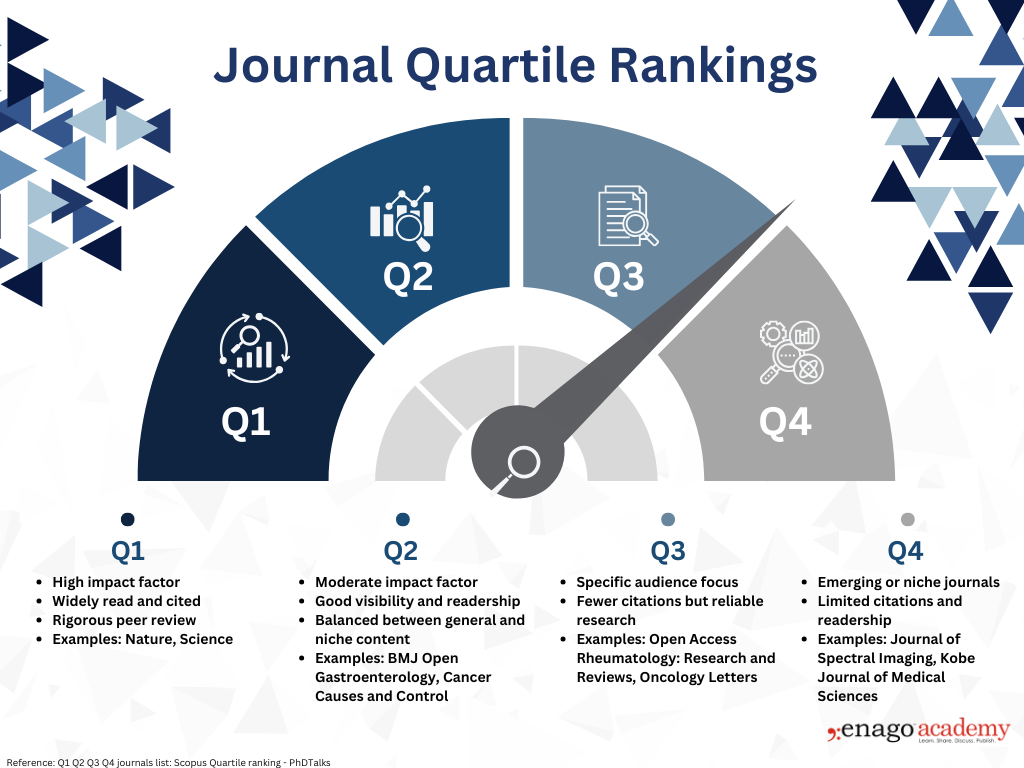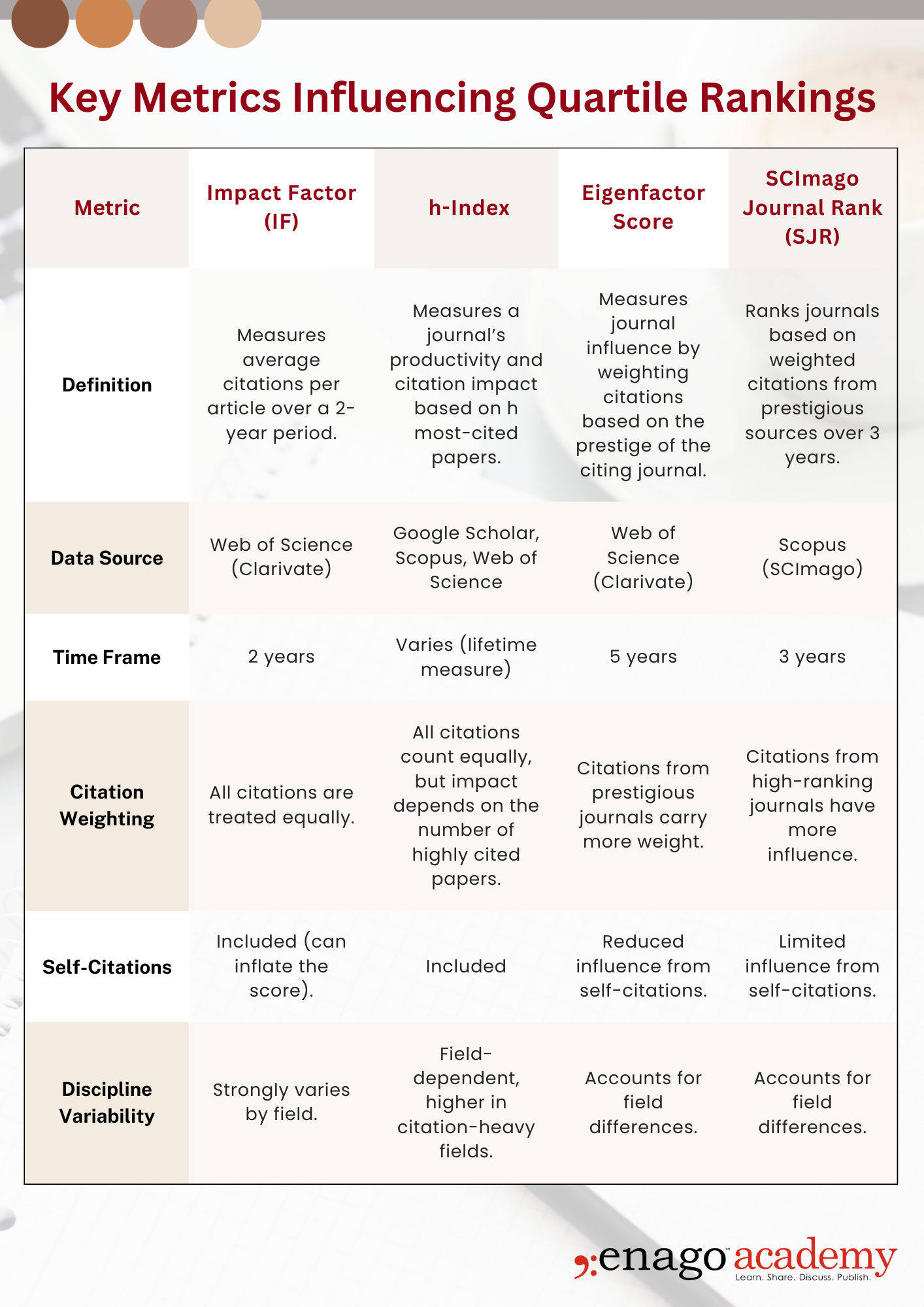From Q1 to Q4: Understanding journal quartiles for effective journal selection

Getting published in a high-impact journal is a significant milestone for researchers. However, achieving this requires an understanding of how journals are evaluated and ranked. One of the most widely used ranking systems is the journal quartiles, which helps to assess the quality and impact of scholarly journals within a specific field.
Journal quartiles categorize journals into four groups based on their relative impact within a discipline. These groups are designated as Q1, Q2, Q3, and Q4. Q1 journals represent the top 25% of publication with highest impact, featuring the most influential and widely cited research. Conversely, Q4 journals fall within the bottom 25%, typically indicating lower visibility and citation rates. It’s important to note that journal quartile rankings can vary significantly across disciplines, reflecting differences in publication volume, citation practices, and research trends. This classification system helps researchers, institutions, and funding bodies evaluate the credibility of journals, make informed publishing decisions, and enhance the reach and influence of one’s research.
 The classification of journals into quartiles is based on citation metrics, which serve as indicators of a journal’s impact within the academic community. The most commonly used metrics include the Impact Factor (IF), h-Index, Eigenfactor Score, and the Scimago Journal Rank (SJR). These measures evaluate the frequency and significance of citations that articles in a journal receive, offering a quantitative way to compare journals within the same field. Let’s understand these metrics better with the help of the infographic below:
The classification of journals into quartiles is based on citation metrics, which serve as indicators of a journal’s impact within the academic community. The most commonly used metrics include the Impact Factor (IF), h-Index, Eigenfactor Score, and the Scimago Journal Rank (SJR). These measures evaluate the frequency and significance of citations that articles in a journal receive, offering a quantitative way to compare journals within the same field. Let’s understand these metrics better with the help of the infographic below:
Choosing the Right Platform for Your Research
Publishing in Q1 journals is often seen as the pinnacle of academic success due to their high impact, rigorous peer-review and broad scholarly influence. Several factors contribute to the allure of publishing in these journals:
- Q1 journals typically have a wider readership and higher citation rates, which can increase the reach of a research paper within the academic community.
- Many research institutions use Q1 journal publications as a key metric for evaluating research productivity, which may factor into evaluation for promotions, tenure, and academic positions.
- A record of publishing in Q1 journals can enhance grant applications by demonstrating the quality and significance of the research.
- Publishing in high-visibility journals can create opportunities for academic collaboration and professional recognition within a field.
Understanding the role of journal quartiles helps researchers make informed decisions about where to submit their work and how best to communicate their findings to the intended audience.
Aligning Research with the Right Audience
By carefully considering these factors, researchers can make informed decisions about where to submit their work. This approach helps researchers share their findings with the right audience, supporting their academic and professional growth.
1. Assess the depth and scope of your research
Researchers may choose Q1 journals for high-impact studies with broad relevance, while they might find Q2–Q4 journals more suitable for specialized or preliminary work.
2. Clarify your primary publishing goal
Whether it is visibility, career advancement, or reaching a niche audience. Aligning your goals with the journal’s strengths ensures a better fit.
3. Use reputable journal selection tools
While no single tool searches journals based on quartiles alone, resources like Enago Open Access Journal Finder can help identify reputable journals that align with your research focus. To avoid predatory journals, researchers often consult multiple trusted databases, such as Scopus, Web of Science, or DOAJ, which provides comprehensive indexing and verification.
While Q1 journals offer significant advantages, publishing in these top-tier outlets is highly competitive. Their standards demand novel research with rigorous study design and compelling results. Additionally, high rejection rates – often exceeding 90%, make acceptance challenging. Furthermore, their time-intensive peer-review process further delays publication, which may not align with urgent career or project deadlines.
To improve their chances of success, researchers should focus on conducting impactful research that addresses pressing questions in their field. Collaborating with experienced researchers can help refine the study methodology and elevate the quality of the work. Additionally, seeking professional editing and guidance from trusted services like Enago’s Substantive Editing and Top Impact Scientific Editing, one can ensure that the research is clear, coherent, and adheres to the specific requirements and guidelines of Q1 journals.
However, it is also important to recognize that publishing in Q2–Q4 journals can be a strategic and responsible choice. Especially, for early-career researchers looking to build their publication portfolio, gain visibility, and contribute meaningfully to their field. These journals often have a broader scope and may offer faster review and publication times, allowing research findings to reach the academic community more efficiently.
By maintaining ethical publishing practices, selecting journals that align with the research scope, and prioritizing scientific integrity over journal rankings, researchers can maximize their academic impact and achieve publication success.





 Specialized for Niche Feilds
Specialized for Niche Feilds Reaching a Focused Audience
Reaching a Focused Audience Faster Publication
Faster Publication Steppingstones for Researchers
Steppingstones for Researchers



